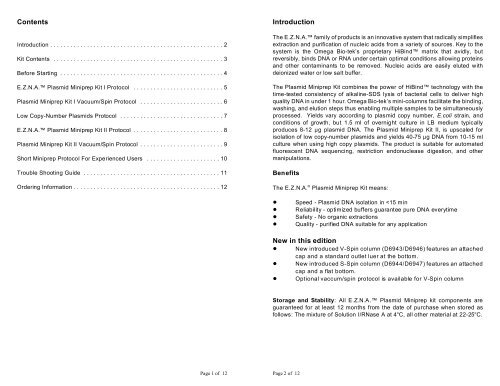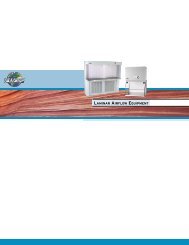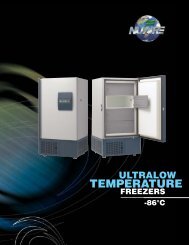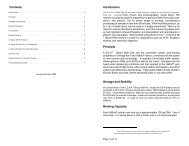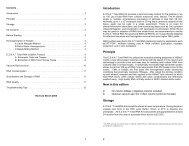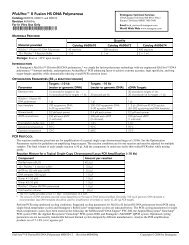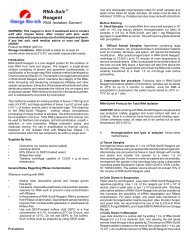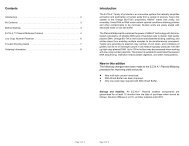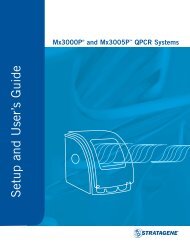E.Z.N.A. ® plasmid miniprep kit I Protocol (PDF Version)
E.Z.N.A. ® plasmid miniprep kit I Protocol (PDF Version)
E.Z.N.A. ® plasmid miniprep kit I Protocol (PDF Version)
Create successful ePaper yourself
Turn your PDF publications into a flip-book with our unique Google optimized e-Paper software.
ContentsIntroduction ....................................................2Kit Contents ...................................................3Before Starting .................................................4E.Z.N.A. Plasmid Miniprep Kit I <strong>Protocol</strong> ...........................5Plasmid Miniprep Kit I Vacuum/Spin <strong>Protocol</strong> .........................6Low Copy-Number Plasmids <strong>Protocol</strong> ...............................7E.Z.N.A. Plasmid Miniprep Kit II <strong>Protocol</strong> ...........................8Plasmid Miniprep Kit II Vacuum/Spin <strong>Protocol</strong> .........................9Short Miniprep <strong>Protocol</strong> For Experienced Users ......................10Trouble Shooting Guide .........................................11Ordering Information ............................................12IntroductionThe E.Z.N.A. family of products is an innovative system that radically simplifiesextraction and purification of nucleic acids from a variety of sources. Key to thesystem is the Omega Bio-tek’s proprietary HiBind matrix that avidly, butreversibly, binds DNA or RNA under certain optimal conditions allowing proteinsand other contaminants to be removed. Nucleic acids are easily eluted withdeionized water or low salt buffer.The Plasmid Miniprep Kit combines the power of HiBind technology with thetime-tested consistency of alkaline-SDS lysis of bacterial cells to deliver highquality DNA in under 1 hour. Omega Bio-tek’s mini-columns facilitate the binding,washing, and elution steps thus enabling multiple samples to be simultaneouslyprocessed. Yields vary according to <strong>plasmid</strong> copy number, E.coli strain, andconditions of growth, but 1.5 ml of overnight culture in LB medium typicallyproduces 8-12 g <strong>plasmid</strong> DNA. The Plasmid Miniprep Kit II, is upscaled forisolation of low copy-number <strong>plasmid</strong>s and yields 40-75 g DNA from 10-15 mlculture when using high copy <strong>plasmid</strong>s. The product is suitable for automatedfluorescent DNA sequencing, restriction endonuclease digestion, and othermanipulations.BenefitsThe E.Z.N.A. ® Plasmid Miniprep Kit means:! Speed - Plasmid DNA isolation in
Kit ContentsE.Z.N.A. Plasmid Miniprep Kit IProduct Number D6942-00D6943-00D6944-00D6942-01D6943-01D6944-01D6942-02D6943-02D6944-02Purifications 5 50 200HiBind Miniprep Columns (I) 5 50 2002 ml Collection Tubes 5 50 200Solution I 3 ml 20 ml 60 mlSolution II 3 ml 20 ml 60 mlSolution III 3 ml 20 ml 80 mlBuffer HB 3 ml 30 ml 120 mlElution Buffer 1 ml 10 ml 30 mlWash Buffer Concentrate 12 ml 40 ml 3 x 40 mlRNase A, Concentrate 25 l 100 l 400 lInstruction Booklet 1 1 1E.Z.N.A. Plasmid Miniprep Kit IIProduct Number D6945-00D6946-00D6945-01D6946-01D6945-02D6946-02Purifications 5 50 200HiBind Miniprep Columns(II) 5 50 2002 ml Collection Tubes 5 50 200Solution I 5 ml 30 ml 120 mlSolution II 5 ml 30 ml 120 mlSolution III 5 ml 40 ml 2 x 80 mlBefore StartingBriefly examine this booklet and become familiar with each step. Prepare allcomponents and have the necessary materials ready before starting.Supplied ByUser:Microcentrifuge capable of at least 10,000 x g.Sterile 1.5 ml centrifuge tubes.Absolute (96%-100%) ethanol15 ml centrifuge tubes (Product No. D6945 & D6946 only)Centrifuge with swinging bucket rotor (D6945 & D6946only)IMPORTANT 1. Add vial of RNase A to bottle of Solution I provided. Store at 4 o C.2. DNA Wash Buffer Concentrate is to be diluted with absoluteethanol as follows:D6942-00, D6943-00 andD6944-00D6945-00 and D6946-00D6942-01, D6943-01 andD6943-01D6945-01 and D6946-01D6942-02 and D6945-02D6945-02 and D6946-02Add 18 ml 100% ethanolAdd 60 ml 100% ethanol toeach bottleAdd 60 ml 100% ethanolStore diluted DNA Wash Buffer at room temperature3. Check Solution II and Solution III before use for saltprecipitation. Redissolve any precipitation by warming at37°C.Note: All steps must be carried out at room temperature.Buffer HB 5 ml 30 ml 120 mlElution Buffer 1 ml 10 ml 30 mlWash Buffer Concentrate 12 ml 40 ml 3 x 40 mlRNase A, Concentrate 50 l 100 l 400 lInstruction Booklet 1 1 1Page 3 of 12Page 4 of 12
E.Z.N.A. Plasmid Miniprep <strong>Protocol</strong> IProduct Number D6942, D6943 & D69441. Inoculate 5 ml LB/ampicillin (50 g/ml) medium placed in a 10-20 mlculture tube with E.coli carrying desired <strong>plasmid</strong> and grow at 37Cwith agitation for 12-16 h. It is strongly recommended that an endAnegative strain of E.coli be used for routine <strong>plasmid</strong> isolation. Examples ofsuch strains include DH5 ® and JM109 ® .2. Pellet 1.5-5 ml bacteria by centrifugation at 10,000 x g for 1 min atroom temperature.3. Decant or aspirate medium and discard. To the bacterial pellet add 250l Solution I/RNase A. Resuspend cells completely by vortexing.Complete resuspension of cell pellet is vital for obtaining good yields.4. Add 250 l Solution II and gently mix by inverting and rotating tube 4-6times to obtain a cleared lysate. A 2 min incubation at room temperaturemay be necessary. Avoid vigorous mixing as this will shear chromosomalDNA and lower <strong>plasmid</strong> purity. (Store Solution II tightly capped when notin use.)5. Add 350 l Solution III and gently mix by inverting several times untila flocculent white precipitate forms. Centrifuge at 10,000 xg for 10minutes at room temperature.6. CAREFULLY aspirate and add the clear supernatant to a clean TypeI HiBind <strong>miniprep</strong> column (blue) assembled in a 2 ml collection tube(provided). Ensure that the pellet is not disturbed and that no cellulardebris is carried over into the column. Centrifuge 1 min at 10,000 x g atroom temperature to completely pass lysate through column.7. Discard liquid and wash column with 500 l Buffer HB and Centrifuge 1 minat 10,000 x g. This step ensures that residual protein contamination isremoved and must be included for downstream applications requiring highquality DNA. This step can be skipped if the downstream applicationsdon’t require high quality <strong>plasmid</strong>, such as enzyme digestion or otherscreening methods.8 Discard flow-through liquid and wash the column by adding 750 l of WashBuffer diluted with ethanol. Centrifuge 1 min at 10,000 x g as above anddiscard flow-through.Note: Wash Buffer Concentrate must be diluted with absolute ethanol before use. Seelabel for directions. If refrigerated, Wash Buffer must be brought to room temperaturebefore use.9. Optional step: repeat wash step with another 750 l Wash Buffer.Page 5 of 1210 Centrifuge the empty column for 1 min at 10,000 x g to dry the columnmatrix. Do not skip this step - it is critical for removing ethanol fromthe column.11. Place column into a clean 1.5 ml microcentrifuge tube. Add 50 l to100 l (depending on desired concentration of final product) ElutionBuffer (supplied) or sterile deionized water directly onto the columnmatrix and centrifuge 1 min at 10,000 x g to elute DNA. Thisrepresents approximately 75-80% of bound DNA. An optional secondelution will yield any residual DNA, though at a lower concentration.12. Yield and quality of DNA: determine the absorbance of an appropriatedilution (20- to 50-fold) of the sample at 260 nm and then at 280 nm. TheDNA concentration is calculated as follows:Page 6 of 12DNA concentration = Absorbance 260× 50 × (Dilution Factor) g/mlHigh copy number <strong>plasmid</strong>s generally yield up to 25 g of DNA from 5 mlculture. The ratio of (absorbance 260)/(absorbance 280) is an indication ofnucleic acid purity. A value greater than 1.8 indicates > 90% nucleic acid.Alternatively, quantity (as well as quality) can sometimes best bedetermined by agarose gel/ethidium bromide electrophoresis bycomparison to DNA samples of known concentrations. Typically, themajority of the DNA eluted is in monomeric supercoil form, thoughconcatamers may also be present.Vacuum/Spin <strong>Protocol</strong> for Plasmid Extraction (V-Spincolumn only)Carry out cell culture, lysis, neutralization, and loading onto HiBind ® DNA column asindicated previous protocols (step 1-5). Instead of continuing with centrifugation,follow steps blow.Note: Please read through previous section of this book before using thisprotocol.1. Prepare the vacuum manifold according to manufacturer’ s instructionsand connect the V-Spin column to the manifold.2. Load the clear supernatant from step 5 to the V-Spin column I (blue).3. Switch on vacuum source to draw the sample through the column and turnoff the vacuum.4. Wash the column by adding 500 l HB Buffer, draw the wash buffer throughthe column by turn on the vacuum source.5. Wash the column by adding 750 l DNA wash buffer, draw the wash bufferthrough the column by turn on the vacuum source. Repeat this step withanother 750 l DNA wash buffer.
6. Assemble the column into a 2 ml collection tube and transfer the columnto a micro centrifuge. Spin 1 minute to dry the column.7. Place the column in a clean 1.5 ml microcentrifuge tube and add 50-100lElution Buffer or water. Stand for 1-2 minute and centrifuge 1 minute to eluteDNA.Low Copy-Number PlasmidsLow copy <strong>plasmid</strong>s generally give 0.1-0.5 g DNA per ml overnight culture. Forroutine screening of recombinant clones, 5 ml culture should provide ample materialfor agarose gel visualization or restriction digest analysis. However, the method canbe modified to essentially double the yield if necessary. Start with 10 ml bacterialculture, and pellet cells either successively 1.5 ml of culture at a time, or centrifugefor 10 min at 5,000 x g in a 15 ml centrifuge tube. Proceed to step 3 (page 5) anddouble the volumes of Solutions I, II, and III. Continue as above using only oneHiBind DNA column per 10 ml culture. There is no need to increase the volumesof Buffer HB and DNA Wash Buffer used.Note: This method is not recommended for high copy number<strong>plasmid</strong>s because above 5 ml culture, the HiBind mini-columnquickly becomes saturated. In this situation we recommendprocessing of multiple samples from the same culture. Alternatively,use the E.Z.N.A. Plasmid Miniprep Kit II (product No. D6945&D6946), a new member of the EaZy Nucleic Acid family that allowsprocessing of 10-15 ml cultures using the mini-column format andgenerally yields 40-70 g <strong>plasmid</strong> DNA with high-copy <strong>plasmid</strong>s.E.Z.N.A. Plasmid Miniprep <strong>Protocol</strong> IIProduct Number D6945 & D6946Note: Using the following protocol with E.Z.N.A. Plasmid Miniprep Kit I(D6942, D6943 & D6944) will not improve yields significantly with high-copy<strong>plasmid</strong>sdue to the lower column binding capacity.The E.Z.N.A. Plasmid Miniprep Kit II allows rapid and reliable isolation ofgreater than 50 g <strong>plasmid</strong> DNA using the spin-column format. There is no needfor organic extractions or alcohol precipitations, and the purified DNA is suitablefor many downstream applications including double stranded DNA sequencing.ProcedureBefore starting, we recommend you refer to page 4 of this booklet for importantinformation on preparation of components and required materials.1. Inoculate 10-15 ml LB/ampicillin (50 g/ml) medium placed in a 50ml culture flask with E.coli carrying desired <strong>plasmid</strong> and grow at37C with agitation for 12-16 h. It is strongly recommended that anendA negative strain of E.coli be used for routine <strong>plasmid</strong> isolation.Examples of such strains include DH5® and JM109®. For low-copy<strong>plasmid</strong>s use no more than 25 ml medium.2. Pellet bacteria by centrifugation at 5,000 x g for 10 min at roomtemperature preferably in a swinging bucket rotor.3. Decant or aspirate medium and discard. To the bacterial pellet add500 l Solution I/RNase A. Resuspend cells completely by vortexingor pipetting up and down. Complete resuspension of the cell pellet isvital for obtaining good yields.4. Transfer cell suspension to a 2 ml microfuge tube and add 500 lSolution II. Gently mix by inverting and rotating tube several timesto obtain a cleared lysate. A 5 min incubation at room temperaturemay be necessary. Avoid vigorous mixing as this will shearchromosomal DNA and lower <strong>plasmid</strong> purity. (Store Solution II tightlycapped when not in use.)5. Add 700 l Solution III and gently mix by inverting several timesuntil a flocculent white precipitate forms. Centrifuge at 10,000 xg for10 minutes at room temperature.6. CAREFULLY aspirate and add 800 l of the clear supernatant to aclean Type II HiBind <strong>miniprep</strong> column (purple) assembled in a 2ml collection tube (provided). Ensure that the pellet is not disturbedand that no cellular debris is carried over into the column. Centrifuge 1min at 10,000 x g at room temperature to completely pass lysatethrough column. Discard the flow-through liquid and add the remaininglysate to the column and centrifuge as above.7. Discard liquid and wash column with 500 l Buffer HB and centrifuge 1min at 10,000 x g. This step ensures that residual proteinPage 7 of 12Page 8 of 12
contaminations removed and must be included for downstream applicationsrequiring high quality DNA.8. Discard flow-through liquid and wash the column by adding 750 l of WashBuffer diluted with ethanol. Centrifuge 1 min at 10,000 x g as above anddiscard flow-through.Note: Wash Buffer Concentrate must be diluted with absolute ethanol before use. Seelabel for directions. If refrigerated, Wash Buffer must be brought to room temperaturebefore use.9. Optional step: repeat wash step with another 750 l Wash Buffer.10. Centrifuge the empty column for 1 min at 10,000 x g to dry the columnmatrix. Do not skip this step - it is critical for removing ethanol fromthe column.11. Place column into a clean 1.5 ml microcentrifuge tube. Add 50 l to100 l (depending on desired concentration of final product and<strong>plasmid</strong> copy-number) Elution Buffer or water directly onto thecolumn matrix and centrifuge 1 min at 10,000 x g to elute DNA. Thisrepresents approximately 75-80% of bound DNA. An optional secondelution will yield any residual DNA, though at a lower concentration.12. Yield and quality of DNA: determine the absorbance of an appropriatedilution (20- to 50-fold) of the sample at 260 nm and then at 280 nm. TheDNA concentration is calculated as follows:DNA concentration = Absorbance 260× 50 × (Dilution Factor) g/mlHigh copy number <strong>plasmid</strong>s generally yield up to 25 g of DNA from 5 mlculture. The ratio of (absorbance 260)/(absorbance 280) is an indication ofnucleic acid purity. A value greater than 1.8 indicates > 90% nucleic acid.Alternatively, quantity (as well as quality) can sometimes best bedetermined by agarose gel/ethidium bromide electrophoresis bycomparison to DNA samples of known concentrations. Typically, themajority of the DNA eluted is in monomeric supercoil form, thoughconcatamers may also be present.Vacuum/Spin <strong>Protocol</strong> for Plasmid Extraction (V-Spin column only)Carry out cell culture, lysis, neutralization, and loading onto HiBind ®DNA column asindicated previous protocols (step 1-5). Instead of continuing with centrifugation, followsteps blow.Note: Please read through previous section of this book before using this protocol.Short Miniprep <strong>Protocol</strong> For Experienced UsersNote: All steps are to be performed at room temperature. Refer to page 4 for importantnotes on preparation of components.1. Pellet cells from 1.5-5 ml (Plasmid Miniprep KitI) or 10-15 ml (Plasmid Miniprep Kit II)overnight culture.2. Resuspend cells in 250 l (Plasmid MiniprepKit I) or 500 l (Plasmid Miniprep Kit II)Solution I/RNase A.3. Add 250 l (Plamsid Miniprep Kit I) or 500 l(Plasmid Miniprep Kit II) Solution II. Mix gentlyby inverting 4-6 times to obtain cleared lysate.A brief incubation at RT may be required.4. Add 350 l (Plasmid Miniprep Kit I) or 700 l(Plasmid Miniprep Kit II) Solution III and mixwell to form white precipitate.5. Centrifuge at maximum (at least 10,000 x g)speed 10 min.6. Transfer cleared lysate to a blue (PlasmidMiniprep Kit I) or purple (Plasmid Miniprep KitII) HiBind DNA column placed in a 2 mlcollection tube. Centrifuge 1 min at max speed.Discard liquid.7. Wash column with 500 l Buffer HB.Centrifuge 1 min at max speed. Discard liquid.8. Using same collecting tube, wash column with750 l DNA Wash Buffer diluted with ethanol.Centrifuge 1 min at max speed.9. Optional: Wash column a second time with 750l DNA Wash Buffer.10. Centrifuge empty column 1 min at max speedto dry.11. Elute <strong>plasmid</strong> DNA with 50-100 l ElutionBufer or water.1. Prepare the vacuum manifold according to manufacturer’ s instructions andconnect the V-Spin column to the manifold.2. Load the clear supernatant from step 5 to the V-Spin column I (purple).3. Switch on vacuum source to draw the sample through the column and add theremaining lysate to the column . Turn off the vacuum.4. Follow the same steps in Vacuum/Spin protocol in page 6 to wash and eluteDNA from column.Page 9 of 12Page 10 of 12
Trouble Shooting GuideProblem Likely Cause SuggestionsLow DNA yields Poor cell lysis Only use LB or YT medium containingampicillin or other proper antibiotic. Donot use more than 5 ml (with high copy<strong>plasmid</strong>s or 10 ml with low copy<strong>plasmid</strong>s) culture with the basicprotocol.No DNA eluted.High molecularweight DNAcontamination ofproduct.Optical densities donot agree with DNAyield on agarose gel.Lower elutionefficiencyBacterial cultureovergrown or notfresh.Low copy-number<strong>plasmid</strong> usedWash BufferConcentrate notdiluted with absoluteethanol.Over mixing of celllysate upon additionof Solution II.Trace contaminantseluted from columnincrease A 260.Cells may not be dispersed adequatelyprior to addition of Solution II. Vortexcell suspension to completely disperse.Increase incubation time with Solution IIto obtain a clear lysate.Solution II if not tightly closed, may needto be replaced. Prepare as follows: 0.2N NaOH, 1% SDS.The pH of Elution Buffer or water has tobe 8.0Do not incubate cultures for more than16 hr at 37 o C. Storage of cultures forextended periods prior to <strong>plasmid</strong>isolation is detrimental.Such <strong>plasmid</strong>s may yield as little as0.5g DNA from a 5 ml overnightculture. Increase culture volume to 10ml and follow suggested modificationswith Plasmid Miniprep Kit I or use thePlasmid Miniprep Kit II with 25 mlculture.Prepare Wash Buffer Concentrate asinstructed above.Do not vortex or mix aggressively afteradding Solution II. Adequate mixing isobtained by simply inverting and rotatingtube to cover walls with viscous lysate.Make sure to wash column as instructedin steps 7 and 8. Alternatively, rely onagarose gel/ethidium bromideelectrophoresis for quantitation.Related ProductsProduct No. Product Name DescriptionE.Z.N.A. ® Plasmid Miniprep SystemD6942-01/02D6943-01/02D6944-01/02D6945-01/02D6946-01/02D7042-01/02D7043-01/02D7045-01/02D7046-01/02Plasmid Miniprep Kit IPlasmid Miniprep Kit IIHigh Performace PlasmidMiniprep Kit IHigh Performace PlasmidMiniprep Kit IIE.Z.N.A. ® Plasmid Midi/Maxi Isolation SystemIsolation of up to 30g<strong>plasmid</strong> in 15 minutesIsolation of up to 70g<strong>plasmid</strong> in 15 minutesIsolation of up to 30g<strong>plasmid</strong> from end A+bacterial in 25 minutesIsolation of up to 70g<strong>plasmid</strong> from end A+bacterial in 25 minutesD6904-01/02 Plasmid Midiprep Kit Midipreps in spin columnformat. Yield up to 200g<strong>plasmid</strong>D6922-01/02 Plasmid Maxiprep Kit Maxipreps in spin columnformat. Yield up to 1mg<strong>plasmid</strong>D7004-01/02High Performace PlasmidMiniprep KitE-Z 96 ® Plasmid Isolation SystemIsolation of up to 200g<strong>plasmid</strong> from end A+bacterial strains.D1097-01/02 96 well Plasmid Kit Isolation of <strong>plasmid</strong> in 96well formatNOW YOU CAN FIND US IN CYBERSPACE!Visit our web site (http://www.omegabiotek.com) and learn more about OmegaBio-tek. You can browse our product list, place orders, or ask technicalquestions.RNA visible onagarose gel.Plasmid DNA floatsout of well whileloading agarose gelRNase A not addedto Solution I.Ethanol notcompletely removedfrom columnfollowing washsteps.Add 1 vial of RNase to each bottle ofSolution I.Centrifuge column as instructed to drythe column before elution .References1. Ausubel, F.M. et al. (1989) Current <strong>Protocol</strong>s in Molecular Biology, Vol. 2, John Wiley & Sons,New York.2. Sambrook, J., Fritsch, E.F. and Maniatis, T. (1989) Molecu lar Cloning: A Laboratory Manual,2nd edition, Cold Spring Laboratory, Cold Spring Harbor, New York.3. Sambrook, J., Fritsch, E.F. and Maniatis, T. (1982) Molecu lar Cloning: A Laboratory Manual,1st edition, Cold Spring Laboratory, Cold Spring Harbor, New York.DH5 is a Registered Trademark of Life Technologies, Inc.JM109 is a Registered Trademark of Promega Corporation.Page 11 of 12Page 12 of 12


